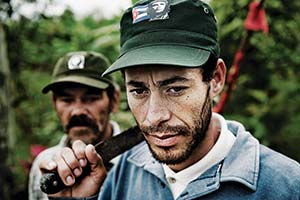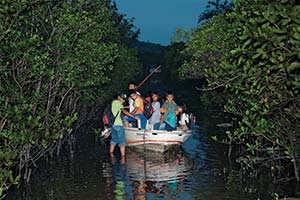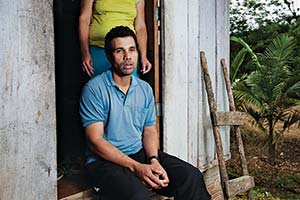Source: Mother Jones

In Brazil, people with some of the world’s smallest carbon footprints are being displaced-so their forests can become offsets for SUVs.
I am standing in the shadow of General Motors‘ $1 tree. It’s a native guaricica, with pale white bark and a spreading crown that looms about 40 feet above my head. Hanging from its trunk is a small plaque that identifies it as tree No. 129. I’ve come here, to the verdant chaos of Brazil’s Atlantic forest, to understand the far-reaching and politically explosive controversies taking shape in diplomatic corridors thousands of miles away over the fate of trees like this one.
No. 129 stands in the heart of the Cachoeira reserve in the state of Paraná-one of the last slivers of a forest that once blanketed much of the country’s southeastern coast. Just 7 percent of the Atlantic forest remains, but it is still one of the Earth’s richest centers of biodiversity, home to a wealth of plants and creatures comparable to the Amazon’s. On the way here, our group-led by Ricardo Miranda de Britez and his team of forestry experts from the Brazilian conservation group Society for Wildlife Research and Environmental Education (SPVS)-walked past clusters of yellow-and-white orchids, stepped over the footprints of an ocelot, kept an eye out for the endangered golden lion tamarin, and were bitten by, it seems, every one of the thousands of species of insects native to the area.
But our journey is not focused on the rare creatures in the forest. It’s about the forest itself-the trees that are our partners in respiration, inhaling carbon dioxide, exhaling oxygen, and storing the carbon in their trunks and leaves. That simple process makes them one of Earth’s most potent bulwarks against climate change (a.k.a. a "carbon sink"); but when they are cut and burned, all that stored carbon is released into the atmosphere. Already, some 32 million acres of tropical rainforest are destroyed each year, an amount of land equivalent to the state of Mississippi’s; deforestation, according to the United Nations, is responsible for roughly one-fifth of all greenhouse gas emissions.
What will it cost to keep those trees standing? And who’s going to pay for it? The challenge of assigning precise values to an increasingly rare commodity-wild trees-and indeed the question of whether they are a commodity at all, is one of the most hotly contested in the climate world.
IT WAS AN unusual deal that landed tree No. 129 at the center of the debate. Between 2000 and 2002, the US-based Nature Conservancy struck an alliance with three of the planet’s leading carbon emitters: General Motors, Chevron, and American Electric Power. Together the corporations gave the environmental group $18 million to purchase 50,000 acres of Brazilian Atlantic forest, much of which had been degraded by grazing. Three reserves were created: Serra do Itaqui, financed with $5 million from AEP; Morro da Mina, paid for with $3 million from Chevron; and Cachoeira, underwritten by $10 million from GM. (GM’s role in the project survived the company’s bankruptcy, which means that No. 129 is now partially owned by you and me.) SVPS was brought in to manage the reserves, which together form one contiguous forest known as the Guaraqueçaba Environmental Protection Area. You’ll see Guaraqueçaba promoted on the Nature Conservancy’s website as an example of corporate partnerships that make "an invaluable contribution to the preservation of the planet’s biodiversity." What you won’t see is what the companies get out of the deal: the potentially lucrative rights to the carbon sequestered in the trees.
At tree No. 129, de Britez takes out a tape measure and unspools it around the trunk. We’re at one of the 190 carbon dioxide measuring stations-each a group of trees with numbered plaques-scattered around the Guaraqueçaba forest. Documenting the bulk of the reserve’s trees is an ongoing enterprise, like tracking tagged whales.
"We measure the biomass of these trees and their carbon sequestration," de Britez says as a ranger picks up the other end of the tape measure and writes down No. 129’s stats. It’s 3 feet in diameter and about 45 feet tall. He estimates the carbon it contains at 95 kilograms-just under one-tenth of a ton. At $10 a ton, the upper end of the range at which carbon offsets trade in the US, No. 129 is worth about $1. Scale up to the two to three tons of carbon per acre that de Britez estimates across the 50,000-acre reserve, and the potential payoff, in addition to the public relations value, comes into focus.
The trees in the Cachoeira reserve could never offset even a fraction of GM’s total carbon footprint-a single Hummer H2 (which the company started producing the same year it signed on to the Guaraqueçaba project) would require about 50 trees to offset. But the Nature Conservancy and its partners aimed to use the Brazilian reserves as a test case for preserving forests via corporate carbon credits. "The investors wanted to be pioneers in the carbon-sink field," de Britez explains. "They had in mind to start working on this before other companies."
All three companies, as it happens, had aggressively lobbied the Clinton administration against signing the 1997 Kyoto climate accord and stayed mum when President Bush withdrew from it. But they hedged their bets, figuring that the Brazilian forests could be turned into offsets to sell in places (like Europe) where Kyoto’s emission limits did apply, or could be held in reserve in case the US ever established its own limits.
By the time the companies were ready to begin preparing their credits for sale, however, the UN had refused to allow "avoided deforestation" projects-those that buy forestland and then promise not to cut the trees-as an offset for industries seeking to buy their way out of emission limits. Credits generated from projects like Guaraqueçaba were excluded from the international carbon market launched by Kyoto, a market that now accounts for more than $126 billion in offset transactions. The offsets could be sold, however, in the United States, where the $700 million domestic carbon offset market is unregulated (and where prices are generally half those of Kyoto-regulated offsets).
Manyu Chang, a forest scientist who is the coordinator for climate policy for the state of Paraná, explained the problem with avoided-deforestation credits to me at her office in the state capital of Curitiba. For starters, she said, trees-living beings, after all-are far less predictable than, say, windmills. They are subject to the vagaries of fires and disease, both of which are increasing due to climate change. Each species absorbs carbon at different rates depending on factors like the altitude, soil, and weather. Then there’s the problem of "leakage"-when deforestation simply shifts from protected zones to unprotected ones, creating no overall emissions reduction. And finally, the UN did not want to open the door to a perverse sort of extortion: A country could threaten to open its lands to logging unless it was paid to not do so.
More fundamentally, Chang notes, when companies create reserves on already forested lands, their contribution to the fight against climate change is limited: "Do they get the credit for simply enhancing what was there already?" José Miguez, one of Brazil’s top climate officials, told me that during the Kyoto talks his government opposed using its forests to enable northern industries to pollute more. "The forest is there," he said. "You can’t guarantee it will absorb extra carbon. The General Motors plan gives a false image to the public in the United States. For us, they are pretending to combat climate change."
THERE IS ANOTHER vexing question inherent in preserving forests: What happens to the people who use the land? Efforts to protect biodiversity in the dwindling wildlands of the world have increasingly run into a discomfiting tension between the impulse toward absolute preservation and the needs of people-many of them indigenous-who have lived sustainably in forestlands for decades or centuries. Such tensions are playing out in the new economics of carbon offsets.
With a preserve designed in large part to safeguard stored carbon, a new set of imperatives comes into play. Turning trees into carbon credits requires knowing how to extrapolate from carbon measurements, like the ones of tree No. 129, to determine a forest’s potential as a carbon sink. It requires knowing as precisely as possible how many trees there are and of what size-which means minimizing the unpredictable activities of human beings, as small scale as they might be.
 Villagers like Jonas de Souza can no longer hunt in the forest they’ve used for generations.
Villagers like Jonas de Souza can no longer hunt in the forest they’ve used for generations.
For many generations, the Guaraqueçaba forest was home to the Guarani Indians, but their dominion waned as the Brazilian government encouraged subsistence farmers to settle and clear the land. Today the two populations coexist, living alongside the reserves or in communities nearby and relying on what remains of the forest for everything from food to building materials. There are more than a dozen villages around the three reserves, linked by dirt roads and river tributaries traveled by canoe. Most are home to just a few dozen people living in structures of wood and reeds. Jonas de Souza is a 33-year-old farmer who grew up a quarter of a mile from the forest that is now part of the GM-funded Cachoeira reserve. His family grows bananas, cocoa, and coffee on a small plot. He remembers hunting for small prey-roast paca, a large rodent, is a local delicacy-and collecting seeds and hearts of palm. But now, signs have gone up at the edge of the forest: No hunting, fishing, or removal of vegetation. A state police force, the Força Verde, or Green Police, patrols the three reserves, as well as a larger state-sanctioned preservation area, to enforce the restrictions.
"Now," says de Souza, "I don’t have the right to go out and do what I used to do when I was 12, 14, 15 years old. I’d grab my fishing rod and get a fish to bring to my family or to feed myself. You don’t have the right to walk into the forest to go and cut a heart of palm to eat. I’ll get arrested and I’ll be called a thief."
De Souza says he’s found numerous relics of the Guarani-pipes, an axe, pottery, and burial items. The forest is valuable today, he notes, because his community and those who were here before them have taken good care of it. "We have been here, and still the forests haven’t disappeared. Still the rivers aren’t contaminated. Still the biodiversity isn’t extinct."
 Guarani children on their way home from school.
Guarani children on their way home from school.
One of the goals of the Green Police is to prevent large-scale poaching, particularly of the endangered and highly valuable hearts of palm, as well as exotic primates and birds. Yet officers cited few arrests of individuals linked to major logging, palmito, or wildlife-smuggling enterprises when I joined them on patrol. Many of their enforcement efforts have focused on local people cutting a single palm for its succulent heart-or collecting wood to build their homes. "They’re afraid of us," said Captain Lestechen, a patrol leader, as a group of young boys sitting on a bench eating a heart of palm quickly scattered at the approach of the Força Verde jeep.
Visiting the villages without the Força in tow, I heard numerous stories of people being harassed, arrested, and shot at while looking for food, wood, or reeds. Antonio Alves, a 35-year-old farmer and carpenter-we spoke as he carved a 15-foot log canoe-said he was arrested this year for chopping down a tree to fix his mother’s home in Quara Quara.
 Antonio Alves (above) had to leave his village near GM’s preserve because he can no longer hunt and gather plants in the forest.
Antonio Alves (above) had to leave his village near GM’s preserve because he can no longer hunt and gather plants in the forest.
It’s a stretch to call Quara Quara a village: It’s a cluster of five cabins perched at the end of a small, silted waterway. The only way in is by canoe. Three of the homes have been abandoned-the residents left, Alves said, because they could no longer hunt and gather food in the forest. After his arrest, Alves spent 11 days in jail in Antonina, a one-hour canoe ride away. The lawyer defending him at trial, pro bono, was the town’s mayor, Carlos Machado. Sitting in his expansive office in the town’s colonial-era city hall, Machado told me that he’s represented a string of people like Alves, villagers hauled into court on charges of violating the strict prohibitions in the reserves.
"I know he didn’t go cut that tree down to speculate on the wood," Machado said. "It’s one thing, the wood seller who is destroying [the forest]-this is very different from a caboclo [farmer] who cuts down a tree to build a fence." These distinctions, he said, have been missing from the policies created by the reserves and enforced by the Força Verde (whose officers have received training from SPVS, the Nature Conservancy’s Brazilian partner). Machado has noticed a stream of migrants from the backwoods to his town, which is buckling under the strain. "Antonina is a small town that has few resources for generating income, few possibilities for people who come from the rural zone without skills and without the defenses to live in the urban environment. They stay in the outskirts of town, in the mangrove swamps, in irregular, inhospitable situations. It creates a lot of social problems for us…Through those conservation projects, they created a poverty belt around our town." The migrants also move west to Curitiba, said Machado, where they’re often steered into prostitution or the drug trade.
By excluding villagers from the forests, says Jutta Kill, a researcher with the Forests and the European Union Resource Network who has spent months interviewing locals about the project, the reserves are pulling out the communities’ lifeline. "In this area," she says, "everyone is cash poor but no one goes hungry. If you take the forest away, you take away everything. The preservation projects here are designed to generate offsets for the largest polluters, and they’re doing it by cutting off people from the land." Few of the people here have motors on their boats, she notes; even fewer own cars. People with some of the smallest carbon footprints on Earth are being displaced by companies with some of the biggest.
Back in Curitiba, Chang, the state forestry expert, told me that the conservation groups were trying to create a "zero disturbance" environment in their forests. "Maybe that’s a little obsolete," she said. "Maybe you [should] have 90 percent conservation, not 100 percent. That way you could include the community of people who live there." But that could undermine a system based on assigning a stable, reliable, and tradable value to a living ecosystem.
"The carbon idea is not really tangible to people in the community," Miguel Calmon, the Nature Conservancy’s director of forests and climate in Latin America, acknowledges. Calmon says the conservation groups initially sponsored training programs for local community members in alternate sources of income-cultivating honeybees, organic bananas, local crafts-but the money ran out. Now, he says, the rules are clear: "You can’t go into these private reserves. That land is not their land anyway. If you used to go [into the forest] from your house across the road, now you can’t. That land is already owned."
The supply of forests for offsetting pollution in developed countries is, potentially, almost infinite. There are an estimated 90 billion tons of carbon in Brazil’s forests alone, and billions of tons more are sequestered in Indonesia, the Democratic Republic of Congo, Malaysia, Papua New Guinea, and other nations with substantial tropical forests, which are considered the most vulnerable to deforestation. The world has a major stake in keeping all that carbon where it is. The question now being debated in Washington and Copenhagen is whether the fate of the forests-and their people-will rest on the ability of industries to pay for preserving distant trees rather than reducing emissions closer to home.
